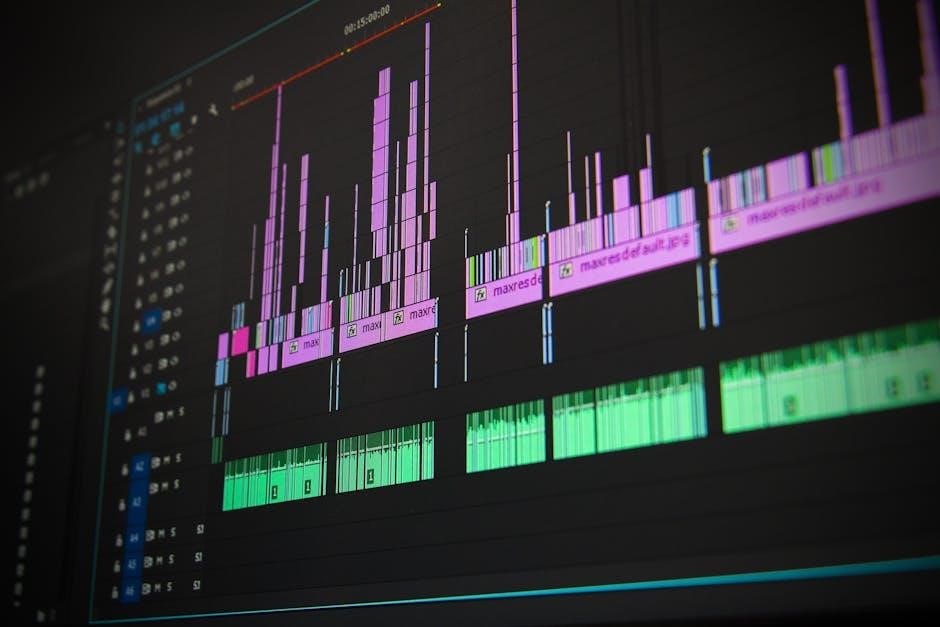
the reconfigured eye: visual truth in the post-photographic era pdf
Overview of “The Reconfigured Eye”
William J. Mitchell’s “The Reconfigured Eye” provides a systematic analysis of the digital imaging revolution. It explores how digital technologies are reshaping our understanding and use of images. This book examines the technology of digital images in detail. It looks closely at how it is changing the way we explore ideas.

William J. Mitchell’s Analysis
William J. Mitchell’s “The Reconfigured Eye” delves into a profound analysis of how digital imaging is transforming our perception of visual truth; Mitchell meticulously examines the shift from traditional‚ film-based photography to the era of digital manipulation and synthesis. He argues that the advent of digital tools has fundamentally altered the nature of photographic images‚ challenging their credibility as objective representations of reality.
Mitchell’s investigation explores the implications of this transformation for various fields‚ including art‚ architecture‚ and media. He analyzes how digital technologies enable the creation of images that were previously impossible‚ allowing for the seamless integration of disparate elements and the alteration of existing scenes. This capability raises critical questions about the authenticity and reliability of visual information in a world increasingly saturated with digitally manipulated imagery.
Furthermore‚ Mitchell’s analysis extends to the ethical considerations surrounding digital image manipulation. He examines the potential for misuse of these technologies‚ particularly in the context of journalism and documentary photography‚ where the integrity of visual evidence is paramount. The book serves as a crucial exploration of the evolving relationship between technology‚ perception‚ and truth in the digital age.

Digital Imaging Revolution
The digital imaging revolution‚ as explored in “The Reconfigured Eye‚” marks a paradigm shift in how images are created‚ manipulated‚ and consumed. This revolution transcends mere technological advancement; it signifies a fundamental change in the nature of photography itself. Digital tools empower users to synthesize entire scenes from geometric models‚ seamlessly insert actors into existing footage‚ and erase elements with ease.
This newfound power raises profound questions about the veracity and objectivity of photographic images. The ability to alter and manipulate images challenges the long-held belief that photographs provide an accurate representation of reality. This has implications across various domains‚ including journalism‚ art‚ and law‚ where visual evidence plays a crucial role.
The revolution also democratizes image creation‚ making sophisticated tools accessible to a wider audience. This accessibility‚ while empowering‚ also necessitates a critical understanding of the potential for misuse and the ethical considerations surrounding digital manipulation. The digital imaging revolution demands a reevaluation of our relationship with images and a heightened awareness of their constructed nature.
The End of Traditional Photography
Mitchell’s “The Reconfigured Eye” posits that traditional‚ film-based photography is nearing its end‚ replaced by a filmless‚ electronic alternative. This shift represents more than just a change in medium; it signifies a fundamental alteration in the photographic process and its relationship to reality.
The core of traditional photography lies in its indexical nature – its inherent connection to the physical world. Light reflected from a scene imprints itself upon film‚ creating a tangible record of what was present at a specific moment in time. Digital photography‚ however‚ severs this direct link. Images are constructed from numerical data‚ allowing for manipulation and alteration that were previously impossible.
This transition raises concerns about the authenticity and trustworthiness of photographic images. The ease with which digital images can be modified challenges the notion of photography as an objective witness. While traditional photography was seen as capturing reality‚ digital photography is increasingly understood as constructing it. This paradigm shift demands a critical reevaluation of how we interpret and trust visual information in the digital age.
Synthesis of Scenes from Digital Models
Mitchell highlights the capacity of computers to synthesize entire scenes from digital geometric models as a key element in post-photographic imaging. This technology allows for the creation of images without any direct reference to a physical scene‚ blurring the lines between reality and simulation.
Instead of capturing light reflected from real-world objects‚ these images are constructed from mathematical descriptions. This opens up possibilities for creating visuals that are impossible to achieve with traditional photography. Digital artists can populate scenes with actors who were never physically present‚ erase objects or individuals‚ and manipulate perspective and lighting in ways that defy the laws of physics.
The ability to synthesize scenes from digital models has profound implications for various fields‚ including entertainment‚ architecture‚ and scientific visualization. It enables the creation of immersive virtual environments‚ realistic simulations‚ and compelling visual narratives. However‚ it also raises concerns about the potential for deception and the erosion of trust in visual media. As the technology becomes more sophisticated‚ it becomes increasingly difficult to distinguish between real and synthetic images.
Ethical Questions Raised
“The Reconfigured Eye” delves into the ethical implications of digital image manipulation‚ questioning the very nature of visual truth in a post-photographic world. With the ability to seamlessly alter and fabricate images‚ the book raises concerns about authenticity‚ manipulation‚ and the potential for misuse. The ease with which digital images can be modified challenges the traditional role of photography as a reliable record of reality.
Mitchell explores scenarios where digital imaging can be used to deceive‚ misinform‚ or create propaganda. He questions the responsibility of image creators and distributors in ensuring the ethical use of this powerful technology. The book highlights the need for critical media literacy‚ urging viewers to question the veracity of images they encounter.
Furthermore‚ “The Reconfigured Eye” examines the impact of digital manipulation on trust and credibility. As the line between reality and simulation blurs‚ it becomes increasingly difficult to discern what is genuine and what is fabricated. This erosion of trust has significant implications for journalism‚ politics‚ and other fields where accurate visual representation is essential. The book calls for a renewed focus on ethical guidelines and responsible practices in the age of digital imaging.
Impact on Visual Truth
“The Reconfigured Eye” meticulously examines the profound impact of digital imaging on our perception of visual truth. Mitchell argues that the advent of digital manipulation technologies has fundamentally altered the relationship between images and reality. No longer can photographs be considered objective records of events‚ as they can be easily altered and synthesized.
The book explores how digital techniques allow for the creation of entirely fabricated scenes‚ the seamless insertion of individuals into existing images‚ and the erasure of unwanted elements. This manipulation capability challenges the traditional notion of photographic evidence and raises concerns about the veracity of visual information. The ease with which images can be altered erodes the trust viewers place in visual media.
Mitchell delves into the implications of this shift for various fields‚ including journalism‚ law‚ and art. He questions the role of photography in documenting history and shaping public opinion‚ given the potential for manipulation. The book emphasizes the need for critical media literacy‚ urging viewers to approach images with skepticism and awareness of the possibilities for digital alteration. “The Reconfigured Eye” ultimately calls for a reevaluation of our understanding of visual truth in the digital age.

Aesthetic Potential
Beyond the ethical considerations‚ “The Reconfigured Eye” also delves into the vast aesthetic potential unleashed by digital imaging technologies. Mitchell explores how these tools empower artists and designers to push the boundaries of visual expression. Digital imaging allows for the creation of surreal and hyperrealistic images that were previously impossible to achieve with traditional photography.
The book examines how artists are using digital techniques to synthesize entire scenes from geometric models‚ creating fantastical landscapes and architectural designs. The ability to seamlessly blend real and virtual elements opens up new avenues for artistic exploration. Mitchell highlights the potential for digital imaging to revolutionize fields such as architecture‚ graphic design‚ and visual arts.
He discusses how the precision and control afforded by digital tools enable artists to refine their compositions and create visually stunning works. The book acknowledges the challenges posed by the democratization of image manipulation‚ but ultimately celebrates the creative possibilities that digital imaging unlocks. “The Reconfigured Eye” envisions a future where artists and designers harness the power of digital tools to create innovative and transformative visual experiences‚ enriching our aesthetic landscape.

Technology of Digital Images
“The Reconfigured Eye” provides a detailed examination of the underlying technology driving the digital imaging revolution. Mitchell meticulously dissects the processes by which images are captured‚ stored‚ manipulated‚ and displayed in the digital realm. He delves into the workings of digital cameras‚ scanners‚ and image processing software‚ explaining how these tools transform analog signals into digital data.
The book explores the concepts of pixels‚ resolution‚ and color spaces‚ providing readers with a fundamental understanding of how digital images are constructed. Mitchell elucidates the algorithms and techniques used for image enhancement‚ compression‚ and restoration. He discusses the role of computer graphics and 3D modeling in creating synthetic images that blur the line between reality and simulation.
Furthermore‚ “The Reconfigured Eye” examines the impact of networking and the internet on the distribution and consumption of digital images. The book highlights the accessibility and manipulability of digital images compared to traditional film-based photography. Mitchell underscores the importance of understanding the technological underpinnings of digital images in order to critically assess their veracity and aesthetic qualities. He emphasizes that knowledge of the technology is essential for navigating the post-photographic era.
Critical Analysis of Digital Imaging
Mitchell’s “The Reconfigured Eye” delivers a robust critical analysis of digital imaging‚ moving beyond mere description to probe its profound implications. He examines how digital manipulation capabilities challenge traditional notions of photographic truth. The book scrutinizes the ease with which digital images can be altered‚ combined‚ and synthesized‚ raising questions about authenticity and objectivity.
Mitchell discusses the potential for digital imaging to be used for propaganda‚ misinformation‚ and deception. He explores the ethical dilemmas faced by photographers‚ journalists‚ and artists in the digital age. “The Reconfigured Eye” investigates the impact of digital imaging on visual culture‚ considering its effects on perception‚ representation‚ and communication.
The book analyzes the ways in which digital images are used to construct and reinforce social narratives. Mitchell delves into the power dynamics inherent in the creation and dissemination of digital images. He examines the role of digital imaging in shaping our understanding of reality and ourselves. This analysis extends to considering how these technologies impact our aesthetic sensibilities and artistic expression. He encourages a thoughtful and critical engagement with the digital image landscape.
Reconsideration of Photographic Truth
“The Reconfigured Eye” compels a fundamental reconsideration of photographic truth in the face of digital technologies. Traditional photography was often perceived as an objective record of reality‚ a direct imprint of the world onto film. However‚ Mitchell argues that digital imaging shatters this notion‚ revealing the constructed nature of all images.
The ease with which digital images can be manipulated challenges the very idea of a photograph as an unmediated representation of reality. Digital tools allow for the seamless alteration of images‚ making it difficult to distinguish between what is real and what is fabricated. This raises profound questions about the trustworthiness of photographic evidence and its role in shaping our understanding of the world.
Mitchell encourages readers to move beyond a naive acceptance of photographic images as objective truth. He advocates for a more critical and discerning approach‚ one that recognizes the inherent biases and manipulations that can be present in any image. He also discusses how the shift from film to digital has altered the relationship between the photographer‚ the subject‚ and the viewer‚ emphasizing the subjective nature of visual representation in the digital age.
Related posts:
Archives
Calendar
| M | T | W | T | F | S | S |
|---|---|---|---|---|---|---|
| 1 | 2 | 3 | 4 | 5 | 6 | 7 |
| 8 | 9 | 10 | 11 | 12 | 13 | 14 |
| 15 | 16 | 17 | 18 | 19 | 20 | 21 |
| 22 | 23 | 24 | 25 | 26 | 27 | 28 |
| 29 | 30 | 31 | ||||
Leave a Reply
You must be logged in to post a comment.